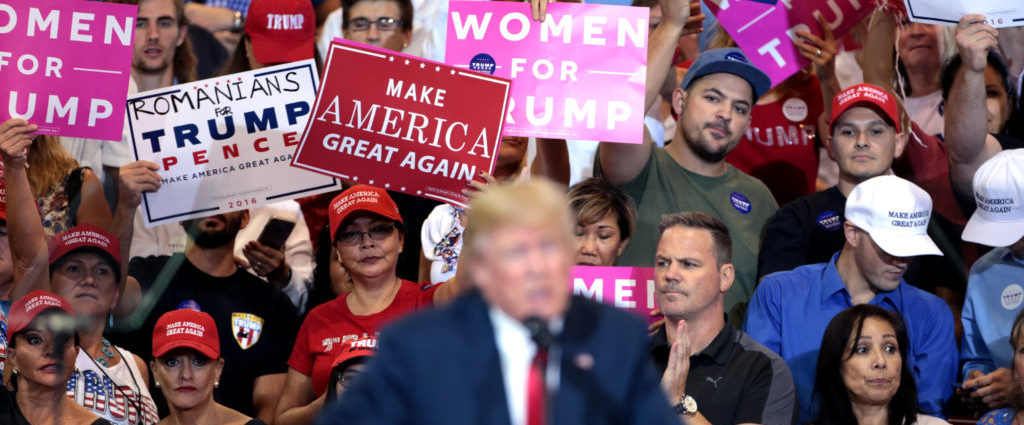In 2016’s US election, 53% of white women voted for Trump. The New York Times exit polls predict this figure to have grown to 55% in 2020. If there is one takeaway from this year’s long-winded election, it is that the US remains a very much divided country.
“President Trump has made it clear again and again that women’s issues are not of importance to him.”
As a white woman, it is difficult to comprehend these figures. Living in New York City, arguably one of the hearts of the Democratic Party in America, I barely encountered the day to day Republican voter, much less a woman. But this simply shows the huge discrepancy between US states and the complicated history of white women’s suffrage in the United States.
President Trump has made it clear again and again that women’s issues are not of importance to him. Whilst it could have been argued that his pre-2016 arguments were all election talk, the past four years in office have proven and legitimized his stance against women. His recent Supreme Court nomination of Amy Coney Barrett represents the antithesis of her predecessor Ruth Bader-Ginsberg – but Barrett encompasses all that a female Trump supporter is. Her opposition to abortion, with Barrett describing Roe v. Wade as a “barbaric legacy”, is a huge endangerment to women’s rights. Yet it has been proven that young Christian women, whilst maybe disagreeing with Trump’s sexist comments and persona, would more likely vote for him over their male counterparts purely for his stance on abortion – perhaps showing their privilege in allowing this one issue to cloud over the rest.
White women and white supremacy
The very foundation of the US is arguably built upon racism, slavery and white supremacy. And Trump has made it explicitly clear that his target audience is white men. From immigration policies to policing, Trump’s presidency has shown prejudice against people of colour and immigrants in the US. Despite the recent anti-racism movement and widespread police protests being an eye-opening moment for people to reflect on America’s systemic racism problem, for some white women it was arguably a threat to their position in American society. In siding with a candidate like Trump, white women made it clear that they identify as white first, a woman second. Whilst Trump specifically targets minorities (women of colour, women who are Latina, Muslim, transgender, etc.), white women have created a falsehood that he supports them, that they are an exception.
“Increased political power and freedom for white women was dependent on asserting the racial inferiority and perpetuating the political subordination of non-white others.” – Louise Newman, White Women’s Rights: The Racial Origins of Feminism in the United States. The Journal of American History
When we dive into the history of the feminist movement, it is shown to have excluded the voices of women of colour for a long time. Even back in 1867, the way to get many white Southerners on board with the suffrage movement was to equate it with white supremacy – claiming that female enfranchisement could eliminate the Black population’s impending political power. Henry Blackwell, one of the founders of the American Woman Suffrage Association reiterated this:“Your 4,000,000 of Southern white women will counterbalance your 4,000,000 of negro men and women, and thus the political supremacy of your white race will remain unchanged.”
Trends in white women’s politics
“white American women have benefitted off of the position of power of their fellow white American men.”
Although the suffrage movement may seem a long time ago, it shows similarities to what is now coined ‘white feminism’ – feminism that does not take into account intersectionality such as race and sexuality. Even after women were given the right to vote through the 19th Amendment, Black women remained disenfranchised through means such as poll taxes and literacy tests. Organisations created that led the women’s suffrage movement disbanded because their aims had been met, at least for white women. This was an early sign that for many white females in America, their idea of feminism was reserved for their race only.
Historically, white American women have benefitted off of the position of power of their fellow white American men. The fragility of a white woman or her purity is what spurred on lynching and accusations of rape – all of which targeted people of colour and lifted up white female voices. Trump’s propaganda against immigrants also specifically targets white women. In his scare-mongering speeches, Trump paints immigrants out to be aggressive rapists who are after white men’s wives. It is a rhetoric that is all too familiar in American history and continues to work effectively on American people.
The argument is much more complex
Despite Joe Biden’s win in the recent election, there is, evidently, still a huge division in American society and a Democrat win will not solve that. The difference in voting between white women and women of colour shows that more must be done to create intersectionality in America. Though of course even within marginalized communities there are anomalies. Therefore, it is important not to generalize when it comes to voting tactics. Despite the anti-racism movement plaguing a majority of Trump’s term as president, polls have shown that the President has made huge gains in support of Hispanic voters. This has already helped shift narratives of what many called the ‘Latinx vote’, illustrating how complex the Latinx identity is and that it is not a one-shoe fit. Similarly, we cannot assume that white women’s leaning towards Trump has a simple justification.
Zazie Atkinson
Image courtesy of Gage Skidmore on Flickr. Image license found here. No changes were made to the image.

